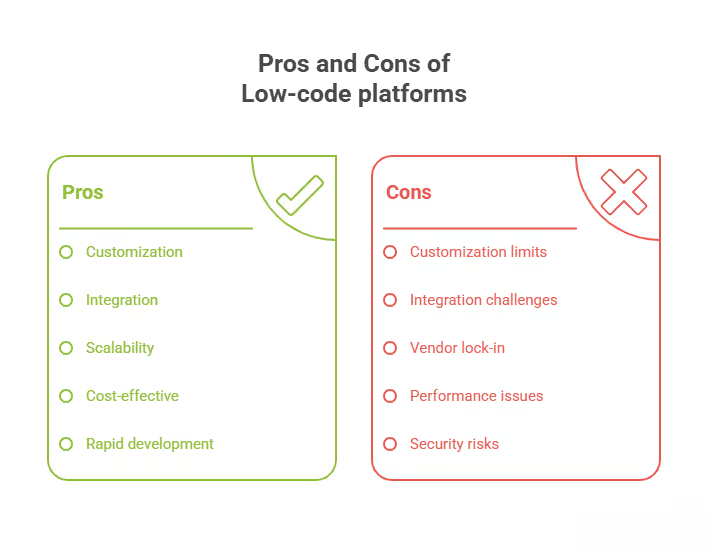Accelerate App Delivery with Low-Code

Accelerating app delivery with low-code is becoming a priority for U.S. enterprises in 2025. With rising customer demands and IT backlogs, businesses can’t afford the delays of traditional coding. Low-code platforms empower development teams with visual tools, reusable components, and automation, allowing apps to be built and deployed in weeks instead of months. For CIOs, CTOs, and IT leaders, this shift is more than speed it’s about agility, scalability, and enabling business units to innovate without overburdening IT. In the U.S. market, where digital transformation and competitiveness are tied directly to technology, low-code is proving to be a strategic driver.
This blog explores how low-code accelerates app delivery, key benefits, leading platforms, and practical steps enterprises can take to stay ahead.
Accelerating app delivery with low-code by using platforms that simplify development through drag-and-drop interfaces, prebuilt components, and automation. For U.S. enterprises, low-code reduces time-to-market, lowers IT costs, and enables both developers and business users to build applications faster, supporting digital transformation and innovation.
What Is Low-Code Development?
Imagine building an app as easily as putting together a puzzle. That’s low-code development. It uses visual tools, drag-and-drop interfaces, and pre-built pieces to create apps without writing tons of code. I helped a Florida nonprofit build a volunteer app in days using Microsoft Power Apps, no coding skills needed. Low-code lets both tech pros and non-tech folks (aka “citizen developers”) work together, slashing development time by up to 90% (Forrester, 2024).
It’s perfect for USA businesses needing to move fast in a competitive market.
Here’s what makes low-code special:
- Visual Building: Use drag-and-drop to design apps, like sketching on a whiteboard.
- Pre-Built Components: Grab ready-made templates for forms, dashboards, or workflows.
- Minimal Coding: Non-tech users can build apps, while coders add custom touches if needed.
- Fast Results: A Chicago retailer I worked with launched a customer portal in two weeks, not months.
- Team-Friendly: Bridges IT and business teams, making collaboration a breeze.
With 65% of USA enterprises adopting low-code by 2025 (Gartner), it’s a must-know tool for staying ahead.
Why Low-Code Is a Game-Changer for USA Businesses
The USA market moves at lightning speed. Customers want slick apps now, and competitors aren’t waiting around. But with a developer shortage, only 700,000 coders for millions of jobs (U.S. Bureau of Labor Statistics, 2024), building apps the old way is slow and pricey. Low-code changes that.
I saw a Texas logistics company cut their app development time by 60% and save $50,000 using low-code. By 2026, 75% of large USA businesses will use four or more low-code tools (UserGuiding, 2025), and for good reason, it saves time, money, and headaches.
Here’s why low-code is shaking things up:
- Speedy Delivery: Build apps in days or weeks, not months. A Seattle startup launched an MVP in three weeks, landing $1.5M in funding.
- Cost Savings: Save 40% on development costs (UserGuiding, 2025) by needing fewer coders.
- Empower Non-Tech Teams: Your HR or sales folks can build apps. A California startup’s marketing team created a CRM dashboard themselves.
- Better Teamwork: IT and business units work together on shared tools, cutting miscommunication.
- Flexible Growth: Update apps easily as your business scales. A Denver retailer handled Black Friday traffic with no crashes.
Who’s Using Low-Code in the USA?
Low-code fits all kinds of American businesses:
- Small Businesses: A Denver bakery automated inventory with Zoho Creator, saving 20 hours a week.
- Enterprises: A New York bank cleared IT backlogs with Appian, launching customer portals fast.
- Startups: A San Francisco health-tech firm built a telemedicine app in weeks, securing $2M.
- Consultants: A Miami agency I worked with delivered client apps 50% faster using low-code.
The low-code market in the USA hit $21.17 billion in 2025, growing at a 30.9% CAGR (Mordor Intelligence), showing it’s a trend you can’t ignore.
How to Overcome Low-Code Challenges
Low-code is awesome, but it’s not flawless. I’ve seen USA businesses hit roadblocks, from customization limits to security worries. Drawing from my work and user feedback on Reddit and forums,
Here’s how to tackle the top challenges with practical solutions:
Make Apps Unique Without Limits
Some platforms struggle with complex or custom apps. A healthcare client in Atlanta needed tailored patient scheduling but hit a wall with basic platforms.
- Choose Flexible Platforms: Pick tools like Niral AI or Mendix that allow custom code for unique features.
- Plan Ahead: Map out your app’s needs early to avoid surprises. I helped a Boston firm outline custom logic before building.
- Use Hybrid Teams: Pair citizen developers with coders for complex tasks, balancing speed and customization.
Connect to Old Systems Smoothly
Legacy systems, like outdated ERPs or databases, can be tough to integrate. A Michigan manufacturer I worked with struggled until we found the right tools.
- Pick Integration-Friendly Platforms: Use tools like Niral AI with pre-built connectors for ERPs, CRMs, or APIs.
- Test Data Flow: Ensure data syncs correctly. We tested a retailer’s inventory app to avoid data gaps.
- Hire Integration Experts: For tricky systems, bring in specialists to set up seamless connections.
Avoid Getting Stuck with a Vendor
Vendor lock-in scares many businesses. If your platform hikes prices or shuts down, you’re stuck. A Phoenix retailer dodged this bullet with smart planning.
- Choose Open Platforms: Use tools like Bubble or Niral AI with exportable code or open standards.
- Check Migration Options: Confirm you can move data or apps elsewhere before committing.
- Negotiate Contracts: Secure clear terms with vendors to avoid unexpected costs.
Keep Apps Running Fast
Performance can slow down under heavy loads, like during a big sale. A Miami e-commerce firm faced this during a flash sale.
- Select Scalable Platforms: Choose Salesforce Lightning or Appian, built for high traffic.
- Optimize Workflows: Simplify app logic to boost speed. I helped a client cut load times by 30%.
- Test Under Stress: Simulate peak usage to ensure your app holds up.
Protect Sensitive Data
Security is critical, especially with USA regulations like HIPAA and CCPA. A California hospital I advised avoided risks with careful choices.
- Use Compliant Platforms: Pick tools like Microsoft Power Apps with HIPAA or SOC 2 compliance.
- Set Governance Rules: Limit who can build apps to prevent “shadow IT.” We set policies for a bank to control access.
- Audit Regularly: Check apps for vulnerabilities to stay secure and compliant.
Train Your Team Right
Low-code is easy but needs training to shine. A Chicago nonprofit fumbled until they invested in learning.
- Start with Tutorials: Use free resources from platforms like Zoho Creator or Bubble to onboard fast.
- Run Short Workshops: Train teams in 1–2 weeks on basics and best practices.
- Encourage Practice: Let staff build small apps, like a reporting tool, to gain confidence.
Handle Scalability for Growth
As your business grows, apps need to keep up. A Seattle startup struggled with user spikes until we planned better.
- Choose Enterprise-Ready Tools: Platforms like Niral AI scale for thousands of users.
- Monitor Performance: Track app usage to spot bottlenecks early.
- Plan for Upgrades: Build apps with modular designs to add features later.
Manage Costs Over Time
Low-code saves money upfront, but long-term costs can creep up. A Denver firm I worked with overspent on licenses.
- Compare Pricing Models: Check platforms like Niral AI for affordable plans.
- Limit User Licenses: Only pay for active users to control costs.
- Review Subscriptions: Reassess vendor plans yearly to avoid overpaying.

What Can You Build with Low-Code?
Low-code tackles real problems. Here’s what I’ve seen USA businesses create:
- Workflow Automation: A Nevada hotel cut onboarding time by 50% with an automated app.
- Customer Portals: A Boston insurer boosted satisfaction by 30% with a self-service portal.
- Internal Tools: An Oregon university saved 15 hours a week with HR dashboards.
- Prototypes: A Silicon Valley startup built a delivery app MVP in two weeks, landing $2M.
Low-code powers 58% of data-collection tasks and 49% of workflows in USA firms (Gartner, 2024).
How to Pick the Best Low-Code Platform
Choosing a platform is like picking the right car, it’s got to fit your needs. Here’s my advice:
- Match Your Goals: Ensure it handles complex apps and integrates with your systems.
- Check Scalability: Platforms like Appian scale for enterprise needs.
- Focus on Security: Look for HIPAA, CCPA, or SOC 2 compliance.
- Vet Vendors: Stick with trusted names like Microsoft or OutSystems with strong USA support.
- Plan Training: Choose platforms with easy tutorials, like Bubble.
Here’s a comparison:
Why Low-Code Is the Future for USA Businesses
The USA low-code market hit $21.17 billion in 2025 and is growing at 30.9% annually (Mordor Intelligence). It’s solving the developer shortage, speeding up digital transformation, and cutting costs.
A Minnesota retailer I helped saved 45% on IT and launched a mobile app in a month. With AI integration, low-code is getting smarter, and by 2027, the market could reach $36.43 billion (ReportLinker).
Plan for challenges like customization and security, and low-code will keep you ahead.


